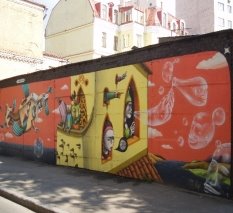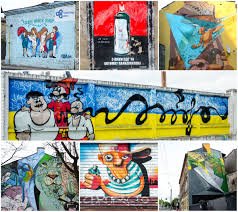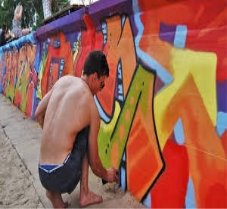From the history of graffiti



Art or vandalism? The history of graffiti.
|
Increasing exposure and attention
|
Famous graffiti artists
|
|
The future of graffiti
|
Not just a modern phenomenon |
paragraph 1 ______________________________
paragraph 2 ______________________________
paragraph 3 ______________________________
paragraph 4 ______________________________
not needed ______________________________
Task 1. Think and answer
Is graffiti a vibrant urban art form or senseless vandalism?
When did graffiti first become popular?
Task 2. Are these ideas for or against graffiti?
Circle FOR or AGAINST
1. Graffiti is a way for people to express their ideas and feelings. FOR/AGAINST
2. It is a waste of money cleaning it up. FOR/AGAINST
3. Graffiti ruins public areas and makes children afraid to play in parks. FOR/AGAINST
4. Graffiti makes a town look more attractive. FOR/AGAINST
5. Why should one person decide what public property looks like? FOR/AGAINST
6. Museums and art galleries now include graffiti in their collections. FOR/AGAINST
7. Graffiti is art. FOR /AGAINST
8. Graffiti is vandalism. FOR/AGAINST
Task 3. Read this article to find out about the history of street art and hear from both sides of the debate.
Write the paragraph headings next to the paragraphs. One heading is not needed.
Art or vandalism?
|
Increasing exposure and attention
|
Famous graffiti artists
|
|
The future of graffiti
|
Not just a modern phenomenon |
paragraph 1 ______________________________
paragraph 2 ______________________________
paragraph 3 ______________________________
paragraph 4 ______________________________
not needed ______________________________
The history of graffiti
The first drawings on walls appeared in caves thousands of years ago. Later the Ancient Romans and Greeks wrote their names and protest poems on buildings. Modern graffiti seems to have appeared in Philadelphia in the early 1960s, and by the late sixties it had reached New York. The new art form really took off in the 1970s, when people began writing their names, or ‘tags’, on buildings all over the city. In the mid seventies it was sometimes hard to see out of a subway car window, because the trains were completely covered in spray paintings known as ‘masterpieces’.
In the early days, the ‘taggers’ were part of street gangs who were concerned with marking their territory. They worked in groups called ‘crews’, and called what they did ‘writing’ – the term ‘graffiti’ was first used by The New York Times and the novelist Norman Mailer. Art galleries in New York began buying graffiti in the early seventies. But at the same time that it began to be regarded as an art form, John Lindsay, the then mayor of New York, declared the first war on graffiti. By the 1980s it became much harder to write on subway trains without being caught, and instead many of the more established graffiti artists began using roofs of buildings or canvases.
The debate over whether graffiti is art or vandalism is still going on. Peter Vallone, a New York city councillor, thinks that graffiti done with permission can be art, but if it is on someone else’s property it becomes a crime. ‘I have a message for the graffiti vandals out there,’ he said recently. ‘Your freedom of expression ends where my property begins.’ On the other hand, Felix, a member of the Berlin-based group Reclaim Your City, says that artists are reclaiming cities for the public from advertisers, and that graffiti represents freedom and makes cities more vibrant.
For decades graffiti has been a springboard to international fame for a few. Jean-Michel Basquiat began spraying on the street in the 1970s before becoming a respected artist in the ’80s. The Frenchman Blek le Rat and the British artist Banksy have achieved international fame by producing complex works with stencils, often making political or humorous points. Works by Banksy have been sold for over £100,000. Graffiti is now sometimes big business.
SOURCES
- https://learnenglishteens.britishcouncil.org/skills/reading/upper-intermediate-b 2-reading/history-graffiti
- https://learnenglishteens.britishcouncil.org/skills/reading/upper-intermediate-b 2-reading/history-graffiti


про публікацію авторської розробки
Додати розробку
